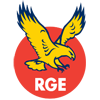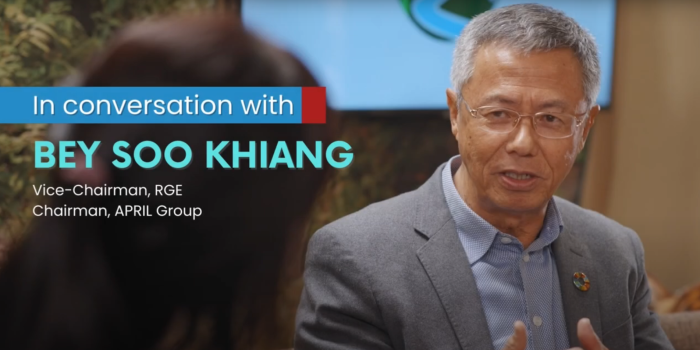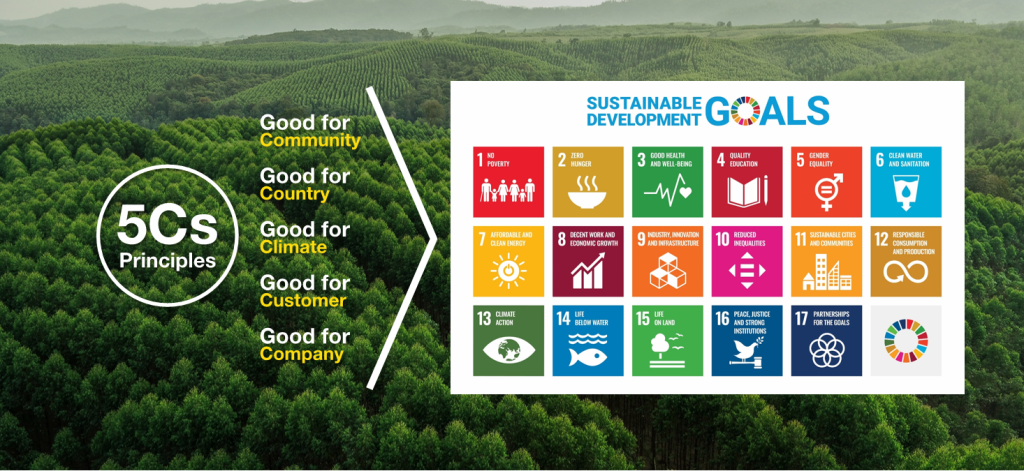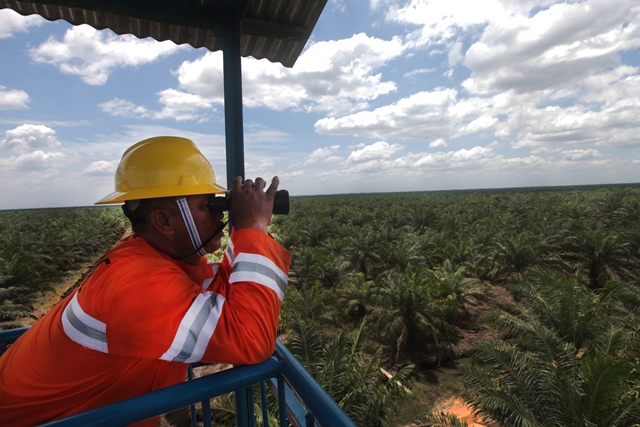Sukanto Tanoto announces Fourth C | WEF Davos highlights & behind-the-scenes
RGE Chairman Sukanto Tanoto was in Davos last month to attend the World Economic Forum (WEF) 2016. Sukanto Tanoto: "Good for Climate" RGE Chairman Sukanto Tanoto...

Latest updates on what's happening in RGE Group

Mr Bey Soo Khiang, Vice Chairman, RGE and Chairman, APRIL Group, attended the Steward Leadership Summit, speaking on a panel discussion titled “Can Addressing Existential Challenges Be Profitable?” As part of the event, Mr Bey also sat down for a discussion with Ms. Joanna Soh, Stewardship Asia Centre’s Chief Operating Officer, to share insights into the core values that drive RGE’s commitment to sustainable business practices, and how these values are built into every aspect of RGE’s approach to its businesses.
For more insights, please find the full transcript below, or watch the full interview online here.
Ms. Joanna Soh:
Can I get you to introduce yourself?
Mr. Bey Soo Khiang:
I’m Bey Soo Khiang. I’m the vice chairman of RGE and I oversee sustainable development, as well as continuous improvement and digital transformation. RGE is a management services company. We get assigned to oversee all the businesses in the group. APRIL is one of the most prominent businesses. In RGE, the businesses are from three verticals. One is a fibre plantation, where we grow trees and harvest them. We then replant them and take the trees to produce various products. The second is palm oil. And the third is energy.
We harvest the fruit from oil palm trees to produce products as well. Our products are biodegradable, renewable, and touch every facet of your life. When you wake up and take a shower, the shampoo that you use contains palm oil and other chemicals. The towel that you use could contain viscose, which is from the fibre plantation and involves rayon production. And when you have a meal, margarine could contain palm oil as well. Also, the car that you drive could be running on biodiesel.
Ms. Joanna Soh:
I think I have a bit of it. It’s in my lipstick, isn’t it?
Mr. Bey Soo Khiang:
Yes. And some of the medicine fillers are even made from fibre plantation material.
Ms. Joanna Soh:
Thank you for giving us a very quick background of RGE. Today, we are at the Steward Leadership Summit. We looked at the scene of values, the right approach for all organisations to build a collective better future. I understand that RGE also operates on the foundation of family values. I was wondering whether you could tell us a little bit more about that?
Mr. Bey Soo Khiang:
The RGE group of companies operate with the purpose of ‘improving lives by managing resources sustainably.’ We do that through what we call the 5Cs model. That means that our businesses must do good for the Community, the Country, the Climate, and the Customer, then it’ll be good for the Company. And these values are sacrosanct in the way we do business.

RGE’s vision is to be one of the largest, best-managed and sustainable resource-based groups, creating value for the Community, Country, Climate, Customer and Company
Ms. Joanna Soh:
And, of course, one of the key projects, and we can see the whole backdrop booth that’s here, it’s of the RER project. Can you tell us a little bit more about the RER project and its purpose?
Mr. Bey Soo Khiang:
When we say to ‘do good for the country, do good for climate’, one of our commitments is to operate our concessions in a very sustainable way. This means for every licensed concession we are given, we convert only about half of the area. What we do is, for the high-conservation-value-forests in the concession, we will conserve them and then we convert the area around it to create a ring of plantations around these conservation forests. So, this ring of plantations protects the conservation forests in a very effective way. In that way, we have a commitment which we call the one-to-one or our nature neutral commitment.

RER uses the Production-Protection Landscape Model as a scalable solution for conservation
This means, for every hectare of plantation, we want to have one hectare of conservation area. And RER was part of that commitment. Because we bought over four production licenses from other owners, these were in the centre of the Kampar Peninsula surrounded by our plantations. After purchasing them, we converted them to restoration licenses, which means that there is no more production and the area is conserved effectively. We are regrowing fauna and flora, as well as preserving the biodiversity and letting them grow naturally.
As you can see, we are very concerned about the area’s biodiversity. So, you can see one of the pictures here, a tiger named Corina. There was a tiger, about 12 months ago, that was ensnared at some villages outside our concessions. The local authorities worked with us to rehabilitate the tiger. After rehabilitation, we released it into our conservation area to make sure that they are sufficiently protected for the future.
Ms. Joanna Soh:
Right. It’s wonderful to hear about the initiatives and I think it’s also the motivation that’s coming from within to be able to serve the community needs better because businesses cannot thrive if the ecosystem around them is not thriving. Now, we know that palm oil and agriculture is a rather challenging industry. How do you suggest that corporations can work better with governments, with NGOs and other stakeholders?
Mr. Bey Soo Khiang:
The government always has some guidelines and rules for the way in which we are supposed to operate the concessions. However, there are areas in which the government is not very active, or where there exists a kind of absence of government activity. For instance, in the community, where we operate in very rural areas such as the plantations and the estates. It’s difficult for the local government to provide, for instance, medical resources, clean water, and electricity to the villages around. So, we help the government by making these available for the villages, since our estates are there. Also, access to education in Indonesia is not an issue. But we know that the quality of education in these remote areas is somewhat of a problem. So, we help by improving the teaching skills of the teachers and the leadership skills of the principals. We also help them with the infrastructure of the schools to improve the quality of education.
For students who are unable to go for further education due to financial difficulties, we sponsor and fund them in the way of scholarships. For adults, we want to help them improve their income level. We do this by teaching them how to be better farmers, so that their yields can be improved. Besides the improvement of yield, we also work with them to have greater market access, so that they can sell their products at a higher price. We also train women in these communities to do things like Batik painting. This way, they can go into the Batik industry as an additional source of income. As a company, we also buy the Batik from them to help them and to make uniforms for our staff. Overall, these help to alleviate poverty in the rural areas. In the future, we also want to eliminate extreme poverty in these areas.

RGE trains women in the communities to do things like Batik painting so that they can go into the Batik industry for an additional source of income.
Ms. Joanna Soh:
I think what you just shared is also a very good example of what we at Stewardship Asia call, the ‘Win-Win-Win’ scenario. Because the business must win, people must win, and yet at the same time, you are also protecting the environment. So that for us is really steward leadership in practice.
Mr. Bey Soo Khiang:
And there’s even an example where we call these fire-free village programmes. At the village level, during the intercrop season, you must clear the land. And for them, the quickest and cheapest way is a match, and for them to burn it. We looked at the issues and developed a fire-free village programme, which essentially is where we go into the village, and appoint somebody on our own payroll to be the chief fireman. The chief fireman’s job is to educate the villages on the hazards of the haze to the health of children and families. We even put in quality-measuring instruments to show them bad air standards. Of course, we must provide them with an alternative means to the match. Hence, we provide them the mechanical means and the chief fireman liaises with us in this.
At the end of the dry season, if they are fire-free, we award them $10,000 USD worth of projects at the community level. For instance, the building of a road or bridge. This is really a win-win situation because the farmers at the village level get better air quality. The company gains because we find that this way of prevention, rather than reacting to fires, saves us money. For every dollar we spend on prevention, we save about $5 from suppression. The country gains because it doesn’t have haze. Even neighbours like Singapore gain because of the reduced probability of haze. So, it’s really win-win-win all round, and this is a way to set about a permanent mindset change in them, by not using fire. The reactive way of suppression is about reacting every day and every year, never changing habits. The fire-free village programme was really a way to encourage permanent change.
Ms. Joanna Soh:
Okay, were you able to take the benefits of this programme and share it with other players within the industry, and thus help to uplift and bring everyone along?
Mr. Bey Soo Khiang:
We started this programme in 2013 and expanded it along the way. In 2015, there was an overall high amount of haze from local fires, but specifically in our area, there were hardly any. The government of Indonesia came to know about it and encouraged us to share our best practices. We set up a fire-free alliance, where we invited companies to come into this forum where we could share how we can tackle this issue. And that has benefitted these companies, some of which are palm oil companies, or even agricultural companies.
Ms. Joanna Soh:
I’ve been taught from long time ago, that it’s always the input and output that are very easy to achieve. The outcome is harder, while the impact is the hardest. I think it really takes a collective effort for you to be able to mobilise so that action can be seen and felt on the ground.
Mr. Bey Soo Khiang:
Absolutely. And when it comes to the issue of fire and haze, our company alone is not good enough. We need other companies in the area to have this fire-free village programme as well, so that there are no fires being caused by farmers, and so we can create a better collective future.
Ms. Joanna Soh:
Can addressing existential challenges really be profitable?
Mr. Bey Soo Khiang:
Well, absolutely. One of the key ways to address climate change is decarbonisation. And a major part of decarbonisation is a reduction in the excessive use of energy. We have conducted a lot of projects to try and reduce excessive energy consumption. The result is, when you lower energy use, you reduce carbon emission, and at the same time, you reduce the cost of doing business. When you reduce water consumption, you have less water to push around in the system, you require less energy and hence lower costs of production. So, the reduction of excessive energy use is clearly profitable from that perspective.
The second example is when we are committed to no deforestation in the future. It forces us to focus on improving the use of existing land, and we call this intensification versus extensification. By focusing on the yield of existing land, we are exercising better practices that improve our yield by close to 25%. That means that there is more wood for production, which means an increase in revenue, and at the same time a reduction in the costs of doing business. This contributes to profitability. The third example is what we call the fire-free village programme.
Instead of spending money to suppress fire, we took the proactive approach of preventing fire. We found that for every dollar spent on prevention, $5 is saved in terms of costs on suppression. A simple example would be if you were to focus on suppression, you would need helicopters on standby, and you need to operate the helicopters, which costs money, during the dry season. So, it’s costly and at the same time, it’s not very cost effective. Because, when the haze comes, the helicopters cannot be flown. Overall, it is much better to focus on prevention.

RGE prioritises fire prevention over fire suppression for its cost- effectiveness
That contributes to the bottom line in terms of reducing costs as well. Focusing on addressing these threats improves the bottom line, and profitability. Focusing on the community is another aspect. If we improve the education of the people in the community, we’re able to hire people from the community. We don’t have to go and recruit people from far away, and this contributes to profitability as well.
Ms. Joanna Soh:
Just to sum it up, based on what I’ve heard from you today, I think all aspects of what we call stewardship values, interdependence, long term view, creative resilience and ownership mentality do exist within the RGE model. Particularly, the ownership mentality shows that from the family founders’ values, it’s cascaded. Interdependence comes in when you recognise that the environment and humanity and business must coexist. And of course, even the fire free village is a true example of creative resilience in action.
Mr. Bey Soo Khiang:
Yes, I mean, I only spoke about the purpose and the 5Cs. We also have the following core values that we call TOPPIC. T for complementary teamwork, O for ownership, P for people development, I for integrity, C for customer, and the last C for continuous improvement. So, there’s a lot of parallel with those values, right? Because you talk about creative resilience, where we are talking about continuous improvement. And our mantra for continuous improvement is that ‘today must be better than yesterday, and tomorrow must be better than today’. There’s always the desire to want to improve through innovation or through better efficiency, better productivity. Ownership is the same thing, because our owner wants us to feel that it’s our business, that we take ownership of issues and to take ownership of dealing with the community.
Ms. Joanna Soh:
And with the ownership mentality, the tendencies that you then want to nurture grow. And of course, you want to pass things on in a better condition than how you have received it, which is stewardship.
Mr. Bey Soo Khiang:
Yes, even complementary teamwork is not just within the company, it’s also with external stakeholders – for example, NGOs, civil service, society, and even local government and the villages working together to create a better collective future.
Ms. Joanna Soh:
Thank you, Mr. Bey, for sharing the core values that exist within RGE. I think it mirrors what we have, what we call the steward leadership compass. This is something that we hope that all organisations can continue to work towards, to have their own living compass as well to operate on. Thank you.